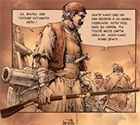today it was perfect weather to take some pictures of my finished German robber-knight´s castle 1520….
The German word “Raubritter” (robber-knight) is a phrase used since the 19th century. The contemporary term in the 16th century was often “Placker” (perhaps to transcript with “flayer”) which is not very well known in modern German language.
By the beginning of the Renaissance era there were big changes in society, weaponry, warfare, culture, art, economy and so on. One of the loosers of these circumstances was the knight. Displaced by trained and disciplined mercenary infantry on the battlefields and left behind by wealthy and prospering towns many knights made use of their old “rights” by simply taking what they needed by force. Sitting in their old fashioned castles they became a famous and romantic symbol of that time, romanticised in later centurys (for example Goethe´s “Götz von Berlichingen”)
So it came to my mind to recreate an idea like one of those castles could have looked like with its inhabitants, keeping it as far as possible historically correct, but also with a touch of humor, romance and a kind of “Mafia-style-setting.”
Some German castles at that time were reinforced with new defences like ditches, obstacles, earth walls, cannon platforms etc. to compete with the improved siege artillery and the growing military power of the German cities. But very often this was in vain. The old castle walls and gates often were no match for the heavy cannon balls.
So this is the imaginary castle of “Hirschenfels” (deer´s rock), located somewhere in Franconia 1520.
A group of mercenaries is returning from a “shopping tour” nearby. Their lord, the bald headed “Herr Kuno von Hirschenfels” is waiting along with his “Zahlmeister” and Landsknechts to get his share from the loot. But most of the castle´s inhabitants are too busy to pay much attention. They have work to do, like gardening, house work or keeping the castle´s weapons in good shape. The city of Nuremberg wants revenge for Kunos raids and Nurembergs siege cannons “Eule” and “Singerin” are able to destroy wooden gates or even Stone walls with a few shots….and this would be the end of Kuno and his “merry men. “
So much for “History”.
The castle: This is a converted foam piece by Noch-Ziterdes, called “Wolvenstein”. (with a “V” to avoid problems with a computer game I think.) I choosed this one because it looked very “German” to me, with its timber frame buildings. I added numerous details and additions, like towers, roofs, portcullis, a wooden hoarding, new windows, drawbridge, fountain, cannons, vegetable garden and so on. I made a new “rock like” base to be able to show the moat and make the castle higher. I made it of styrofoam, shaped with knife and heat, coated with layers of glue and a whole roll of premium 4-layered toilet paper (which was very limited in Germany during the first Corona lockdown in Spring 2020). I spared no effort for this.
It took me about three years to finish the diorama (including longer breaks). This is my biggest and most time consuming diorama so far. I planned to finish this for the Dioramica exhibition in November 2020, but due to Corona unfortunately I had no hurry to complete it.
Figures and accessories are from various brands which I am collecting since 2005….Warlord Games, Games Workshop, Foundry, Assault Group, Artizan, Leopold Dietz, Mirliton, Thomarillion and others.
One of the problems with a closed building in dioramas is that it is hard to see some of the miniatures, but you can look into it from a bird´s view and discover 60 human beings, 3 horses, 1 dog, 2 cats, 3 hens, 1 cock, 1 goat, 8 pigs and one dead goose.
Have fun watching it.
Gott zum Grusse from Bavaria
Thomas
"Return to Castle Wolvenstein."































Photo by thomarillion.de


















 Moderator
Moderator







 Supporting Member (Bronze)
Supporting Member (Bronze)